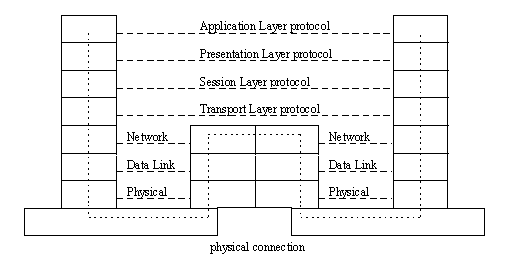 C o m p u t e r N e t w o r k s
C o m p u t e r N e t w o r k s
 Network Basics
Network Basics
Network Basics: OSI model
Explains the Open Systems Interconnection framework for networking standards
![[Previous Page]](../graphic/previcoe.gif)
![[List of Terms Page]](../graphic/termicoe.gif)
![[Table of Content Page]](../graphic/conticoe.gif)
![[List of Products Page]](../graphic/prodicoe.gif)
![[Next Page]](../graphic/nexticoe.gif)
The Open System Interconnection (OSI) Reference Model was developed by the
International Standards Organization (ISO). It is an attempt to build a
framework of layers, in which various protocols in computer networking fit.
The OSI model consists of seven layers which are:
- The Physical Layer: transmits raw data bits over a communication
channel (mostly mechanical and electrical issues)
- The Data Link Layer: guarantees to the network layer that there are
no transmission errors by breaking the input datastream up into frames and
sending back acknowledgement frames
- The Network Layer: controls the operation of the involved subnet; main
issues are routing (determine a way from source to destination) and dealing
with problems of heterogenous networks, e. g. different size requirements of transmitted data blocks
- The Transport Layer: splits up data from the session layer if necessary (segmentation)
and ensures that the pieces arrive correctly
- The Session Layer: allows users on different computer systems to
establish a session between them, i. e. they are able to transfer files or
log into a remote system; the conditions of communication are laid down, for example
full-duplex or half-duplex
- The Presentation Layer: unlike the layers before it is concerned with
the syntax and semantics of the transmitted information; it is concerned
with all aspects of information representation such as data encoding, data
compression and encryption
- The Application Layer: contains a variety of commonly needed protocols
like handling with different terminal types and file systems; a label to identify the communication process, its origin and destination application is added to the transmitted information
Layers 4 to 7 are true end-to-end layers, i. e. the layer on the source
system carries on a communication process with the same layer on the destination
system. In the lower layers the protocols are between a system and its immediate
neighbour, for example the source system and a system "on the way" to the
destination.
Some of the functions of the physical and the data link layer are combined
in the Medium Access Control (MAC) sublayer, which in particular is
important to
Local Area Networks (LANs). It determines how
devices attached to the network gain access to the transmission medium.
A communication between two systems via a relay system (another computer or an
interconnection device), causes the following flow
of information between the OSI architectures of the involved systems:

![[Video]](../graphic/video.gif)
Note that the OSI model does not lay down the specific protocols used to
communicate between two computers on a specific layer. Although ISO
recommends which protocols to use with the OSI model, the model itself
is in proper speaking no
standard of computer networking.
Which protocol in a single layer is actually used, depends on several
factors like the physical network, the needed reliability, etc.
There is also an external source about the
OSI Reference
Model ![[WWW]](../graphic/www.gif) reachable.
reachable.
![[Previous Page]](../graphic/previcoe.gif)
![[List of Terms Page]](../graphic/termicoe.gif)
![[Table of Content Page]](../graphic/conticoe.gif)
![[List of Products Page]](../graphic/prodicoe.gif)
![[Next Page]](../graphic/nexticoe.gif)
Andreas Groessler, 21/08/1995

![[Video]](../graphic/video.gif)
 C o m p u t e r N e t w o r k s
C o m p u t e r N e t w o r k s
 Network Basics
Network Basics
![[Previous Page]](../graphic/previcoe.gif)
![[List of Terms Page]](../graphic/termicoe.gif)
![[Table of Content Page]](../graphic/conticoe.gif)
![[List of Products Page]](../graphic/prodicoe.gif)
![[Next Page]](../graphic/nexticoe.gif)
![[WWW]](../graphic/www.gif) reachable.
reachable.